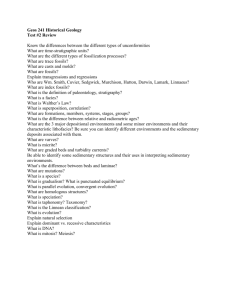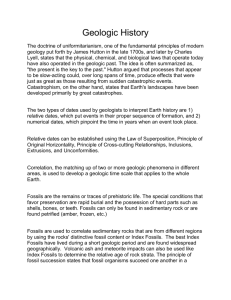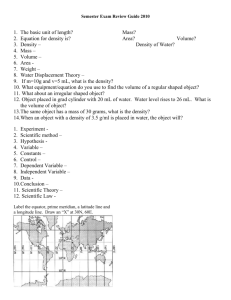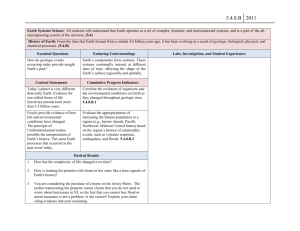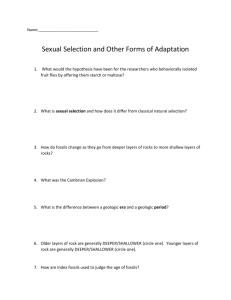GEOL 102 Historical Geology Exam 1 Review History of Historical
advertisement
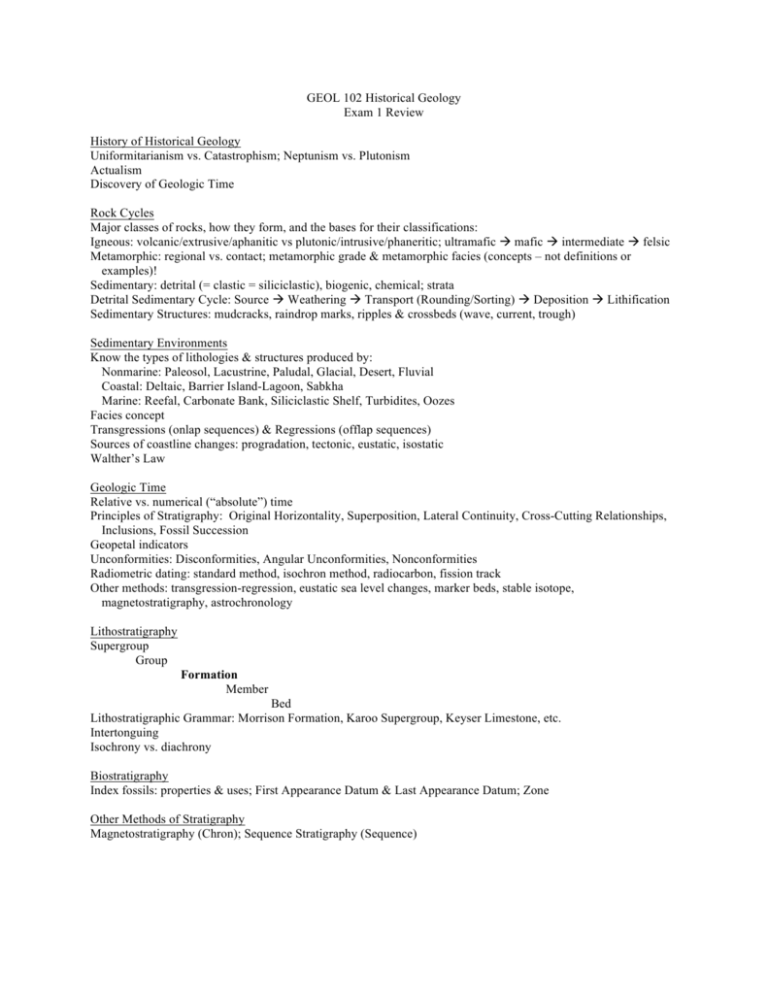
GEOL 102 Historical Geology Exam 1 Review History of Historical Geology Uniformitarianism vs. Catastrophism; Neptunism vs. Plutonism Actualism Discovery of Geologic Time Rock Cycles Major classes of rocks, how they form, and the bases for their classifications: Igneous: volcanic/extrusive/aphanitic vs plutonic/intrusive/phaneritic; ultramafic à mafic à intermediate à felsic Metamorphic: regional vs. contact; metamorphic grade & metamorphic facies (concepts – not definitions or examples)! Sedimentary: detrital (= clastic = siliciclastic), biogenic, chemical; strata Detrital Sedimentary Cycle: Source à Weathering à Transport (Rounding/Sorting) à Deposition à Lithification Sedimentary Structures: mudcracks, raindrop marks, ripples & crossbeds (wave, current, trough) Sedimentary Environments Know the types of lithologies & structures produced by: Nonmarine: Paleosol, Lacustrine, Paludal, Glacial, Desert, Fluvial Coastal: Deltaic, Barrier Island-Lagoon, Sabkha Marine: Reefal, Carbonate Bank, Siliciclastic Shelf, Turbidites, Oozes Facies concept Transgressions (onlap sequences) & Regressions (offlap sequences) Sources of coastline changes: progradation, tectonic, eustatic, isostatic Walther’s Law Geologic Time Relative vs. numerical (“absolute”) time Principles of Stratigraphy: Original Horizontality, Superposition, Lateral Continuity, Cross-Cutting Relationships, Inclusions, Fossil Succession Geopetal indicators Unconformities: Disconformities, Angular Unconformities, Nonconformities Radiometric dating: standard method, isochron method, radiocarbon, fission track Other methods: transgression-regression, eustatic sea level changes, marker beds, stable isotope, magnetostratigraphy, astrochronology Lithostratigraphy Supergroup Group Formation Member Bed Lithostratigraphic Grammar: Morrison Formation, Karoo Supergroup, Keyser Limestone, etc. Intertonguing Isochrony vs. diachrony Biostratigraphy Index fossils: properties & uses; First Appearance Datum & Last Appearance Datum; Zone Other Methods of Stratigraphy Magnetostratigraphy (Chron); Sequence Stratigraphy (Sequence) Geologic Column Chronostratigraphy (Rock) Eonthem Erathem System Series Geochronology (Time) Eon Era Period Epoch Stage Age Geologic Column Grammar: e.g,, Jurassic System (rock) vs. Jurassic Period (time), Upper Jurassic Series (rock) vs. Late Jurassic Epoch (time) GSSPs and GSSAs Plate Tectonics Evidence for moving continents: distribution of fossil plants & animals, sediment patterns, glacial patterns, etc. Continental drift vs. land bridges/sunken continents: models & predictions Polar wander, Sea-floor spreading, paleomagnetism: evidence for moving surface Cross-sectional structure and mineralogy/lithology of Earth: esp.: oceanic vs. continental crust; crust vs. mantle; lithosphere vs. asthenosphere Plate Tectonics: plate boundary types (transform, divergent, convergent); microplates Orogenesis Cycles of mountain building Anatomy of a mountain range: trench, accretionary wedge (mélange), forearc basin, metamorphic belts, igneous arc, foreland basin (flysch & molasse), fold & thrust belt Continent-continent collisions, ophiolites Examples in the modern world Wilson (Supercontinent) Cycles Geochemical Cycles Energy sources for geology: solar, gravity, internal heat Reservoirs (sources and sinks) and fluxes; residence time Positive vs. negative feedback Paleoclimate: components to make climate (insolation, greenhouse gases, position of continents/oceans, albedo) Examples of how plate tectonics drives geochemical cycles and climate: volcanoes; chemical weathering; sedimentation and soils; position of the continents; rise and fall of mountain ranges; rise of fall of the seas Use of δ13C as indicator of past productivity; δ18O as indicator of paleotemperature Fossils & Fossilization Body fossil vs. trace fossils Fossilization potential Common hard part mineralogies Taphonomy & modes of preservation: unaltered, permineralized, recrystallized, replaced, carbonized, impression Transported (allochthonous) vs. in situ (autochthonous) Lagerstätten Ecology Major life habits (producers, consumers, decomposers), suspension feeding Plankton vs. Nekton vs. Benthos (infaunal vs. epifaunal; motile vs. sessile) Evolution Properties of life DNA: its role as genetic code; alleles; variations; mutations Evolution: diversity of living things is product of descent with modification Natural Selection: differential survival and reproduction of variants in a population resulting in change of phenotypes of the descendants: • Variations in all population, some of which is heritable • More are born into populations than can possibly survive • Traits which allow organism to survive and reproduce will be selected for, and will show up in increasing frequency over many generations Evolution ≠ Simple-to-complex; Evolutionary fitness = reproductive success Common ancestry Homologies Analogies Adaptations Vestigial structures Sexual selection Lineage Divergence Correlated Progression Adaptive radiation Niche Partitioning Hybrids Convergence Extinction Mass extinction Living fossils Transitional fossils Heterochrony: Paedomorphosis vs. Peramorphosis Evo/Devo Macroevolutionary change from macroecological change Taxon (taxa): basics of Linnean taxonomy Cladistics & difference of taxonomic philosophy with Linnaean Cladogram: be able to read one Derived vs. primitive vs. reversed vs. convergent characters Monophyletic, Paraphyletic Minimum Divergence Time

